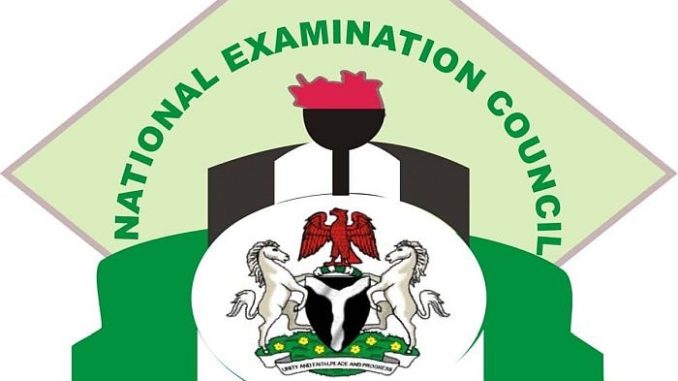
*NECO 2022 CIVIC EDUCATION*
01-10: CDAABAABDD
11-20: DBACBDCDBE
21-30: ACECCADCCA
31-40: AACDCAACBE
41-50: BBBDDACDDC
51-60: CEEAEADBDE
*COMPLETED*
“`THEORY PART BELOW
👇🏿👇🏿👇🏿👇🏿“`
*NECO GCE CIVIC EDUCATION THEORY ANSWERS*
*========================*
*========================*
(1a) COVID-19 is the short name for the coronavirus disease that was first identified in December 2019. The full name of the disease is COronaVIrus Disease 19, with the “CO” standing for corona, “VI” for virus, “D” for disease, and “19” for the year in which the disease was first identified. COVID-19 is caused by the SARS-CoV-2 virus, which is a member of the coronavirus family. This virus is highly contagious and can cause severe respiratory illness in people who are infected. COVID-19 has become a global pandemic, with cases and deaths reported in many countries around the world.
(1b)
(I) Wearing a face mask: One of the most effective ways to prevent the spread of COVID-19 is to wear a face mask when in public or around others who are not part of your household. This helps to reduce the risk of respiratory droplets from infected individuals spreading to others. It’s important to wear a mask that covers your nose and mouth, and to make sure it fits properly.
(II) Practicing good hygiene: Good hygiene practices can help to reduce the risk of infection with COVID-19. This includes washing your hands frequently with soap and water for at least 20 seconds, using hand sanitizer if soap and water are not available, and avoiding touching your face. It’s also important to clean and disinfect frequently touched surfaces and objects, such as doorknobs, tables, and phones.
(III) Maintaining physical distance: Another important preventive measure is to maintain a physical distance of at least six feet from others who are not part of your household. This helps to reduce the risk of respiratory droplets from infected individuals reaching others. It’s also important to avoid crowded places and gatherings where the risk of infection may be higher.
(IV) Getting vaccinated: As vaccines become available, getting vaccinated against COVID-19 can help to reduce your risk of infection and to protect those around you. It’s important to follow the guidance of public health officials and to get vaccinated when it’s your turn.
*========================*
*========================*
(2a) Values are the principles, beliefs, or standards that guide an individual’s behavior and decision-making. They are the qualities that people consider most important in their lives, and they help to shape our attitudes, actions, and behaviors.
(2b)
(I) Providing guidance: Values serve as a moral compass that helps individuals to make decisions and to navigate complex situations. By aligning their actions with their values, individuals can act in ways that are consistent with their beliefs and principles, and can avoid engaging in behaviors that are harmful or unethical.
(II) Promoting social cohesion: Shared values can help to bring individuals and groups together and to create a sense of community. When people share the same values, they are more likely to trust and support each other, and to work together for the common good. This can help to build strong and resilient communities that are able to overcome challenges and achieve shared goals.
(III) Facilitating communication: Values can also help to facilitate communication and understanding between individuals and groups. By understanding each other’s values, people can better appreciate and respect the perspectives and experiences of others, and can communicate more effectively and empathetically. This can help to reduce misunderstandings and conflicts, and can promote greater harmony and cooperation within society.
(IV) Influencing social norms: Values can also influence the social norms and expectations that govern behavior in society. When values are widely held and shared, they can become the basis for social norms, such as the expectation of honesty and fairness in interactions with others. These norms can help to create a sense of order and predictability in society, and can provide a framework for individuals to navigate social situations.
*========================*
*========================*
(3a) Bi-cameral legislature is a type of legislative body that is made up of two chambers or houses. This type of legislature is typically found in parliamentary systems, where the two chambers represent different levels or branches of government.
(3b)
(I) Providing a system of checks and balances: One of the main advantages of a bi-cameral legislature is that it provides a system of checks and balances that can help to prevent any one branch of government from becoming too powerful. By having two chambers with different powers and responsibilities, the legislature can ensure that different perspectives and interests are represented and considered when making decisions. This can help to promote fairness and balance, and can prevent the abuse of power by any one branch of government.
(II) Representing different levels or branches of government: In a bi-cameral legislature, the two chambers typically represent different levels or branches of government. For example, the upper chamber may represent the federal government, while the lower chamber represents the individual states or provinces. This can help to ensure that the interests and concerns of different levels of government are represented and considered in the legislative process.
(III) Allowing for more thorough consideration of legislation: Another advantage of a bi-cameral legislature is that it allows for more thorough consideration of legislation. Because legislation must be passed by both chambers, there is typically more debate and discussion of the issues, and more opportunities for amendments and revisions. This can help to ensure that legislation is well-informed and carefully considered, and can help to prevent hasty or rash decisions.
(IV) Providing opportunities for compromise and consensus-building: In a bi-cameral legislature, the need for legislation to be passed by both chambers can create opportunities for compromise and consensus-building. When there are differences of opinion between the two chambers, members must work together to find common ground and to develop legislation that is acceptable to both sides. This can help to foster collaboration and cooperation, and can lead to more effective and enduring legislation.
*========================*
*========================*
(4a)
Parenthood is the state of being a parent, especially the role of raising and caring for a child or children. It is a legal and social relationship between a parent and their child, which carries with it certain rights and responsibilities.
(4b)
(I) Providing for the physical needs of the child, such as food, clothing, shelter, and medical care.
(II) Providing a safe and nurturing environment for the child to grow and develop in.
(III) Teaching the child values, morals, and social norms that will help them become responsible and productive members of society.
(IV) Being a positive role model for the child and setting a good example for them to follow. This can include being responsible and respectful in relationships and in the community, and being involved in the child’s education and extracurricular activities.
*========================*
*========================*
*SECTION B*
(5)
(I) It allows for a greater range of political views to be represented in government. In a one-party system, only the views of the ruling party are represented, which can lead to political polarization and social unrest.
(II) It encourages political competition, which can lead to better policies and more responsive government. In a one-party system, there is little incentive for the ruling party to improve its policies, as it is the only party with a chance of winning elections.
(III) It allows for a more diverse and representative government. In a one-party system, the ruling party is likely to be dominated by a particular demographic or political group, which can lead to a lack of representation for other groups.
(IV) It provides a check on the power of the ruling party. In a one-party system, the ruling party has complete control over the government, which can lead to abuses of power and corruption. In a multi-party system, the presence of multiple parties can serve as a check on the power of the ruling party.
(V) It promotes political stability. In a one-party system, changes in leadership or shifts in political views can lead to major political upheaval. In a multi-party system, the presence of multiple parties allows for a more gradual and stable transition of power.
*========================*
*========================*
(6a) A political party is a group of individuals who organize to contest elections and hold power in the government.
(6b)
(I) A set of principles and ideologies: Political parties typically have a distinct set of principles and ideologies that they promote and seek to implement through their policies and actions. These principles and ideologies can be based on a wide range of factors, such as social and economic issues, foreign policy, and cultural values.
(II) A hierarchical structure: Political parties are typically organized in a hierarchical manner, with a clear chain of command and decision-making authority. This structure allows for effective coordination and communication within the party, and it helps to ensure that the party’s policies and actions are consistent and coherent.
(III) A mechanism for selecting candidates: Political parties play a key role in the process of selecting candidates for public office. Parties typically have a process for nominating candidates, and they often provide support for these candidates during their campaigns. This can include providing financial support, organizing volunteers, and conducting campaign activities.
(6c)
– All People’s Party (APP)
– Alliance for Democracy (AD)
– All Nigeria Peoples Party (ANPP)
*========================*
*========================*
(7a)
Hard drugs are a category of drugs that are highly addictive and dangerous, and which have severe negative effects on the body and mind.
(7b)
(I) Stimulants: Stimulant drugs, such as cocaine and methamphetamine, are substances that increase activity in the central nervous system, leading to increased alertness, energy, and arousal. These drugs can be abused by taking them in large doses or using them frequently, which can lead to a range of negative effects, including increased heart rate, hallucinations, and agitation.
(II) Depressants: Depressant drugs, such as alcohol and benzodiazepines, are substances that slow down activity in the central nervous system, leading to feelings of relaxation and sedation. These drugs can be abused by taking them in large doses or using them frequently, which can lead to a range of negative effects, including impaired coordination, memory problems, and respiratory depression.
(III) Hallucinogens: Hallucinogen drugs, such as LSD and psilocybin, are substances that alter perception and cause hallucinations. These drugs can be abused by taking them in large doses or using them frequently, which can lead to a range of negative effects, including confusion, anxiety, and psychosis.
(7c)
(I) Oral: Oral administration is the most common method of drug administration, and it involves taking the drug by mouth in the form of a pill, capsule, or liquid. This method allows for the drug to be absorbed by the body through the digestive system.
(II) Injection: Injection is a method of drug administration in which the drug is introduced into the body through a needle, typically into a vein or muscle. This method allows for the rapid absorption of the drug into the bloodstream, which can produce a rapid onset of effects.
(III) Inhalation: Inhalation is a method of drug administration in which the drug is inhaled through the mouth or nose. This method is commonly used for drugs that are volatile and can be vaporized, such as inhalers for asthma or vaporizers for marijuana.
*========================*
*========================*
(8a)
Citizenship is the expression of a public identity. It is the recognition of an official position by a government and the ability to enjoy the rights and privileges following from that position by an individual.
(8b)
(i)Citizenship can be acquired by birth i.e, born by parents who are citizens of the country/state.
(ii). Citizenship can be acquired by naturalization; a citizen of another country can apply for citizenship of another country , where he/she resides.
(iii). Citizenship by registration i.e, through marriage. And it can be acquired by Adoption through legal process.
(iv). Citizenship by descent or when grandparents claimed to have migrated from somewhere.
*COMPLETED*



Leave a Reply